Evolution Game and Simulation Analysis of Disturbance Emergency Disposal of In-Flight Cabin: China Civil Aviation Security Strategy Study
Abstract
:1. Introduction
2. Literature Review
3. Event Tree Analysis of Cabin Disruptions
3.1. Cabin Disruption ETA Model Construction
3.2. Analysis of Event Tree Results for Use of Open Flame or Smoking in the Cabin
4. Model Assumptions and Construction
4.1. Question Description
4.2. Basic Assumptions
4.3. Model Building
4.4. Replicator Dynamic Equation and Evolutionary Stable Strategy
4.5. Evolutionary Stability Analysis of the Strategy of Four Subjects
5. System Dynamics Analysis and Simulation
5.1. System Equilibrium Point Simulation Analysis
5.2. Evolutionary Game Simulation under Dynamic Strategy
5.2.1. Evolutionary Game Simulation under Dynamic Support Strategy
5.2.2. Evolutionary Game Simulation under Dynamic Penalty Strategy
5.3. Evolutionary Game Simulation Trend Analysis
5.4. Empirical Analysis and Simulation
5.4.1. Data and Parameters
5.4.2. Simulation Results
6. Conclusions
6.1. Results
6.2. Recommendations
6.3. Limitations and Future Research
Author Contributions
Funding
Institutional Review Board Statement
Informed Consent Statement
Data Availability Statement
Conflicts of Interest
References
- Bell, K.D.A. An evaluation into the causes of perpetual disruptive passenger behavior. J. Transp. Secur. 2022, 15, 1–22. [Google Scholar] [CrossRef]
- Wang, J.L.; Wang, W.; Wei, C. Prevention mechanism research of airport order disturbance behavior. Rule Law Soc. 2019, 8, 33–34. [Google Scholar]
- Zhang, J. Study on the List of Unruly Behaviors of the Tokyo Convention. J. Beijing Univ. Aeronaut. Astronaut. (Soc. Sci. Ed.) 2015, 28, 32–38. [Google Scholar]
- Liu, Y. Comparative study on the legal regulation on uncivilized passengers’ disturbance behavior. J. Nanjing Univ. Aeronaut. Astronaut. (Soc. Sci.) 2018, 20, 64–69. [Google Scholar]
- Xia, Y.; Wei, Y.X. Criminal responsibility of civil aviation disruptive behavior. People’s Procur. 2017, 736, 12–15. [Google Scholar]
- Paul McFarlane. Linking aviation security failures to human-mediated error. A review of the related literatures with directions for policy and research. J. Transp. Secur. 2020, 13, 33–51. [Google Scholar] [CrossRef]
- MacDonald, R.D.; Leong, Y.C. Pretransport Risk Assessment of Agitated Patients in Air Medical Transport. Air Med. J. 2021, 40, 274–277. [Google Scholar] [CrossRef]
- Rhoden, S.; Ralston, R.; Ineson, E.M. Cabin crew training to control disruptive airline passenger behavior: A cause for tourism concern? Tour. Manag. 2007, 29, 538–547. [Google Scholar] [CrossRef]
- Adjekum, D.K.; Tous, M.F. Assessing the relationship between organizational management factors and a resilient safety culture in a collegiate aviation program with Safety Management Systems (SMS). Saf. Sci. 2020, 131, 104909. [Google Scholar] [CrossRef]
- Gharehbaghi, K.; Hosseinian-Far, A.; Hilletofth, P. The predicaments of environmental impact assessment (EIA) for transport infrastructure: An examination of policy stagnation and progress. Transform. Gov. People Process Policy 2022, 16, 4. [Google Scholar] [CrossRef]
- Xu, W.; Mohamad Nasri, N.F.; Jamaludin, K.A. In-Flight Infection Prevention and Control Training for Cabin Crew in China: A Qualitative Study. Sustainability 2023, 15, 5068. [Google Scholar] [CrossRef]
- Dando, C.J.; Ormerod, T.C. Aviation security by consent using the Controlled Cognitive Engagement (CCE) alternative screening programme. J. Air Transp. Manag. 2020, 86, 101824. [Google Scholar] [CrossRef]
- Wang, Y.; Ling, Y.; Li, J.; Wang, X. Effect of Multi-fractal Characteristic of Aviation Security Personnel’s Visual Search on Passengers’ Abnormal Behavior Identification. J. Saf. Environ. 2023, 1–7. [Google Scholar] [CrossRef]
- Feng, W. Research on civil aviation security event analysis based on deep LSTM model. China Saf. Sci. J. 2021, 31, 1–7. [Google Scholar]
- Zhang, Y.; Feng, W. Evolutionary game research of civil aviation passenger security based on system dynamics analysis. J. People’ Public Secur. Univ. China Sci. Technol. 2021, 27, 76–82. [Google Scholar]
- Yan, Y.; Zhang, J.; Tang, Q. Game analysis of airline freight alliance based on improved prospect theory. J. Beijing Univ. Aeronaut. Astronaut. 2020, 46, 1247–1257. [Google Scholar]
- Feng, W.; Zhang, Y.; He, X. Evolutionary game analysis on strategies of civil aviation security participants under bounded rationality. J. Hefei Univ. Technol. (Nat. Sci.) 2021, 44, 1279–1286. [Google Scholar]
- Keiser, D.; Arenz, M.; Freitag, M.; Wang, Y.L.; Sundqvist, J.; Patel, M.K.; Walker, T. Method to Model the Environmental Impacts of Aircraft Cabin Configurations during the Operational Phase. Sustainability 2023, 15, 5477. [Google Scholar] [CrossRef]
- Yu, J.; Guo, J.; Zhou, C.; Gu, T.; Ma, M. Decision-making Analysis of Preventive Measures for Aviation Safety Accidents Based on Bow-tie-DT-FTA. Fire Control Command Control 2022, 47, 158–164. [Google Scholar]
- Feng, X.; Sang, X.; Zuo, H. Prediction of aviation safety event risk level based on ensemble cost-sensitive deep neural network. J. Beijing Univ. Aeronaut. Astronaut. 2023, 48, 1–15. [Google Scholar]
- Tanveer, M.; Khan, S.; Umar, M.; Yu, Z.; Sajid, M.J.; Haq, I.U. Waste management and green technology: Future trends in circular economy leading towards environmental sustainability. Environ. Sci. Pollut. Res. Int. 2022, 29, 80161–80178. [Google Scholar] [CrossRef] [PubMed]
- Li, Q.; Zhao, D.; Yin, J.; Zhou, X.; Li, Y.; Chi, P.; Han, Y.; Ansari, U.; Cheng, Y. Sediment Instability Caused by Gas Production from Hydrate-bearing Sediment in Northern South China Sea by Horizontal Wellbore: Evolution and Mechanism. Nat. Resour. Res. 2023, 1–26. [Google Scholar] [CrossRef]
- Wang, F.; Liu, X.; Jiang, B.; Zhuo, H.; Chen, W.; Chen, Y.; Li, X. Low-loading Pt nanoparticles combined with the atomically dispersed FeN4 sites supported by FeSA-N-C for improved activity and stability towards oxygen reduction reaction/hydrogen evolution reaction in acid and alkaline media. J. Colloid Interface Sci. 2023, 635, 514–523. [Google Scholar] [CrossRef] [PubMed]
- Yu, L.; Wang, D.; Zeng, N. Supply-Chain Reconfiguration Strategy under the Risk of COVID-19. Chin. J. Manag. Sci. 2023, 1–29. [Google Scholar] [CrossRef]
- Huang, J.; Mao, B.; Wu, X. Study on Liquidation Mechanism Optimization of the Railway Industry Transportation Revenue. J. Beijing Jiaotong Univ. Soc. Sci. Ed. 2023, 22, 2. [Google Scholar] [CrossRef]
- Liu, P.; Dong, X.; Wang, P. A Large Group Decision Making Method Considering Experts’ Non-cooperative Behavior for Investment Selection of Renewable Energy Projects. Int. J. Comput. Intell. Syst. 2022, 15, 1. [Google Scholar] [CrossRef]
- Zhou, M.; Liu, Y.; Zhao, S.; Yang, J. Dual-Attitude Decision-Making Processes of Construction Worker Safety Behaviors: A Simulation-Based Approach. Int. J. Environ. Res. Public Health 2022, 19, 14413. [Google Scholar] [CrossRef]
- Lan, Z.; Yu, J.; Zhu, L.; Yao, Y.; Chen, Z.; Jin, S.; Yang, Y. Hierarchical Topological Model of the Factors Influencing Adolescents’ Non-Suicidal Self-Injury Behavior Based on the DEMATEL-TAISM Method. Sci. Rep. 2022, 12, 17238. [Google Scholar] [CrossRef]
- Coggan, H.; Page, K.M. The Role of Evolutionary Game Theory in Spatial and Non-spatial Models of the Survival of Cooperation in Cancer: A Review. J. R. Soc. Interface 2022, 19, 20220346. [Google Scholar] [CrossRef]
- Scaramangas, A.; Broom, M. Aposematic Signalling in Prey-Predator Systems: Determining Evolutionary Stability When Prey Populations Consist of a Single Species. J. Math. Biol. 2022, 85, 13. [Google Scholar] [CrossRef]
- Venkateswaran, V.R.; Gokhale, C.S. Evolutionary Dynamics of Complex Multiple Games. Proc. R. Soc. B Biol. Sci. 2019, 286, 1905. [Google Scholar] [CrossRef] [Green Version]
- Su, Q.; McAvoy, A.; Wang, L.; Nowak, M.A. Evolutionary Dynamics with Game Transitions. Proc. Natl. Acad. Sci. USA 2019, 116, 51. [Google Scholar] [CrossRef] [PubMed] [Green Version]
- Xiong, X.; Li, J.; Lin, Z. Evolutionary Game and Simulation Analysis of Participating Subjects in Remediation of Heavy Metal Contaminated Cultivated Land under the Ladder Multiple Supervision Model. Sustainability 2023, 15, 4940. [Google Scholar] [CrossRef]
- Zhao, H.; Wang, H.; Jin, S.; He, Z. Evolutionary Game and Simulation Analysis of Collaborative Innovation Mechanisms of Industrial Internet Platform-Based Ecosystem. Sustainability 2023, 15, 4884. [Google Scholar] [CrossRef]
- Chao, Y.; Wang, G. Analyzing the Effects of Governmental Policy and Solar Power on Facilitating Carbon Neutralization in the Context of Energy Transition: A Four-Party Evolutionary Game Study. Sustainability 2023, 15, 5388. [Google Scholar] [CrossRef]
- Li, J.; Li, Y. Evolutionary Game Analysis of Blockchain-enabled Petroleum Engineering Quality with Four Parties. J. Xi’an Shiyou Univ. Nat. Sci. Ed. 2022, 37, 81–91. [Google Scholar]
- Friedman, D. Evolutionary Games in Economics. Econometrica 1991, 59, 637–666. [Google Scholar] [CrossRef] [Green Version]
- Barnabè, F.; Davidsen, P.I. Exploring the potentials of behavioral system dynamics: Insights from the field. J. Model. Manag. 2019, 15, 339–364. [Google Scholar] [CrossRef]
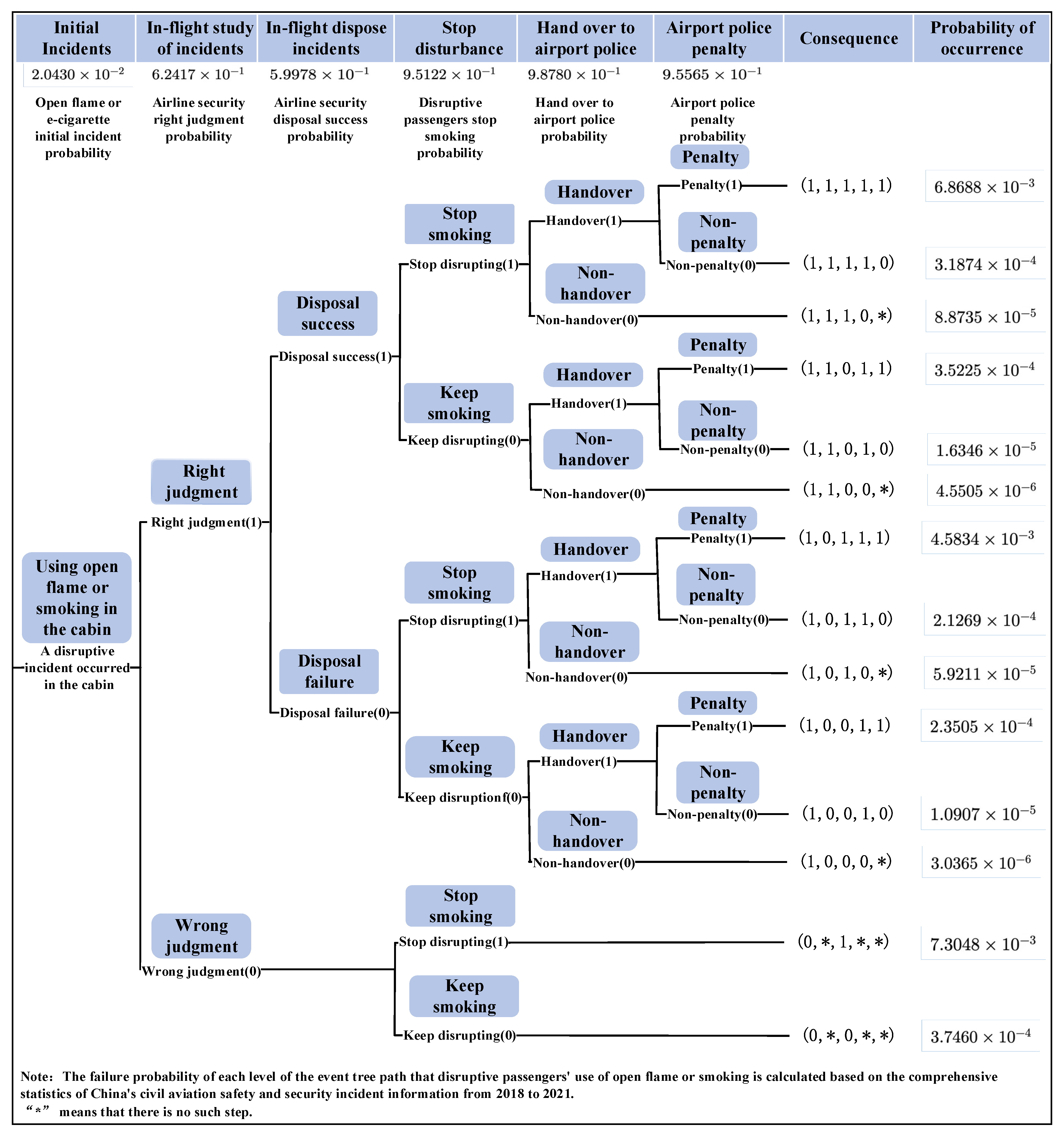

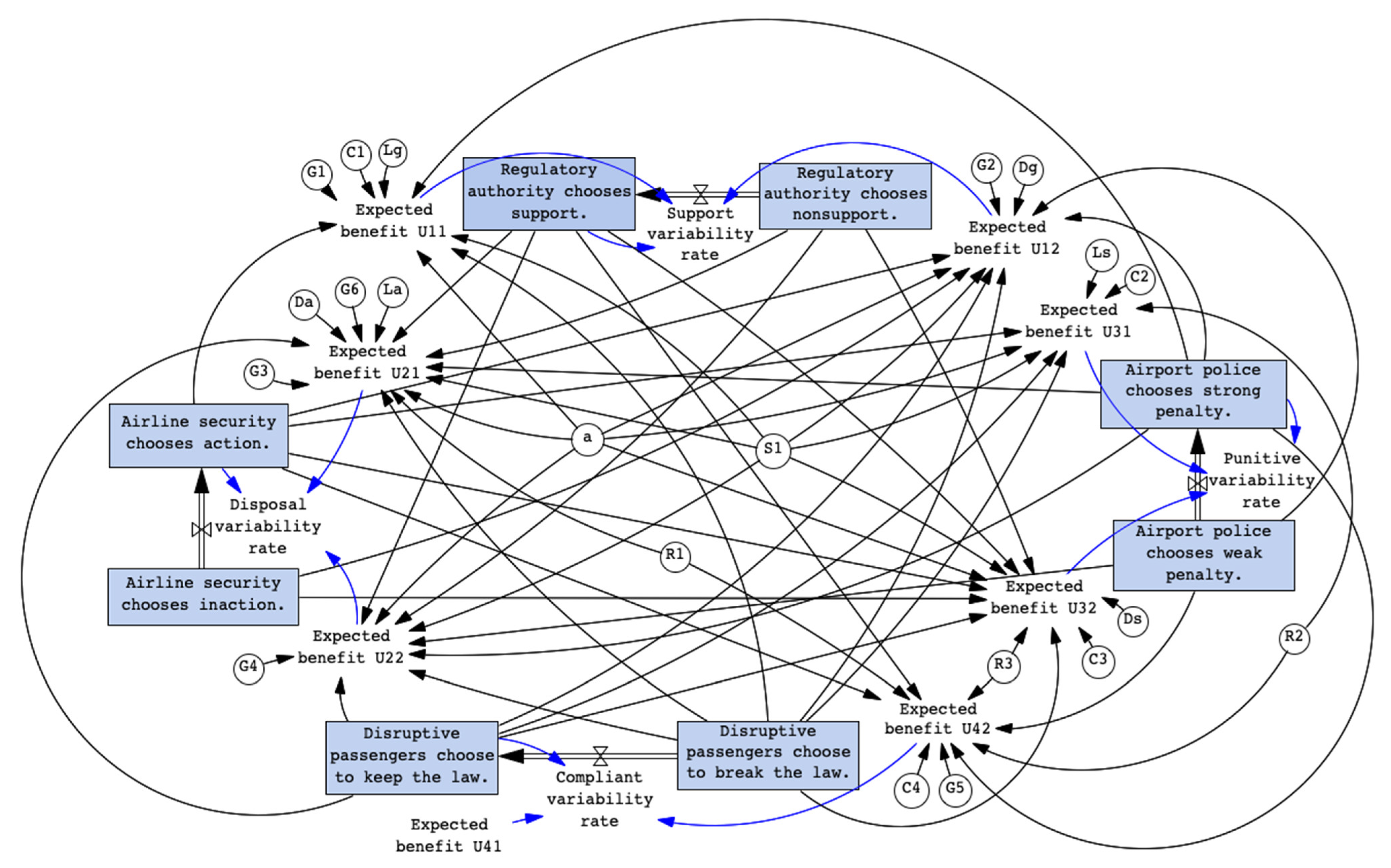

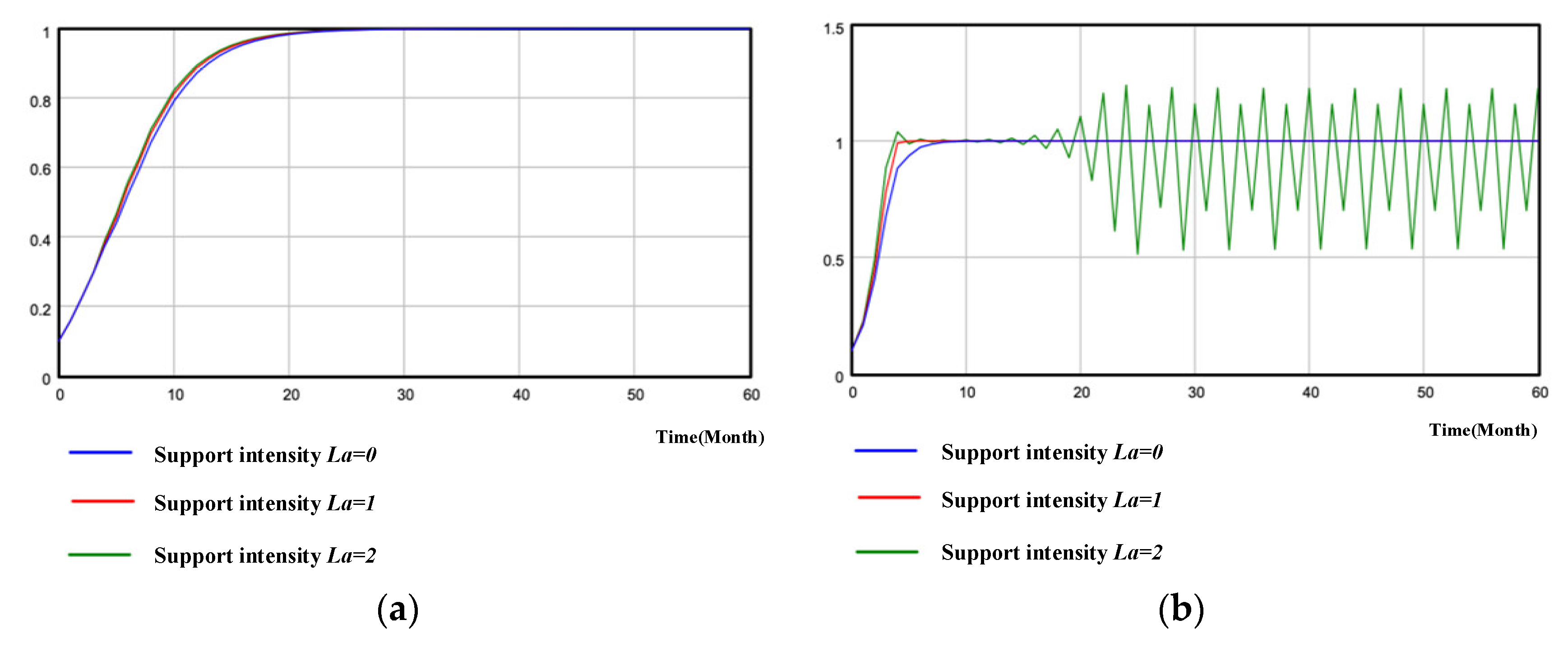
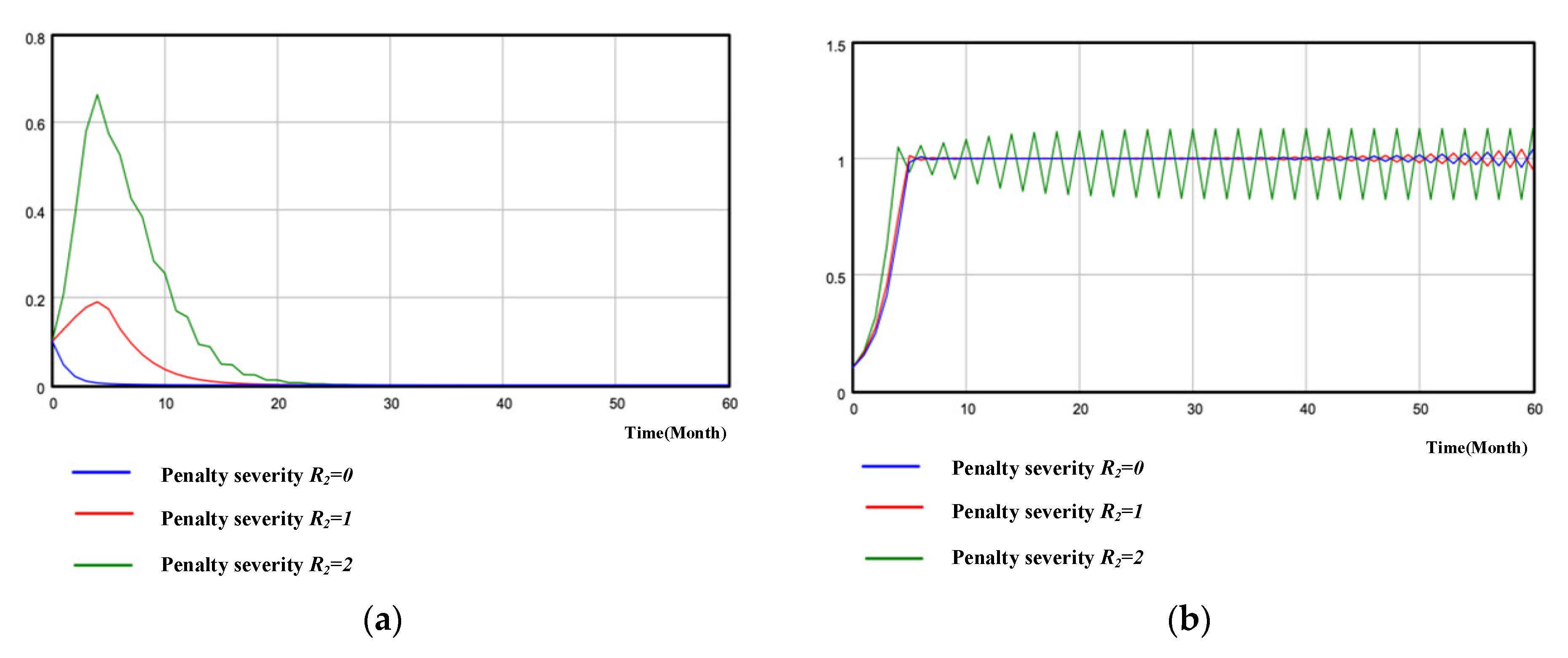
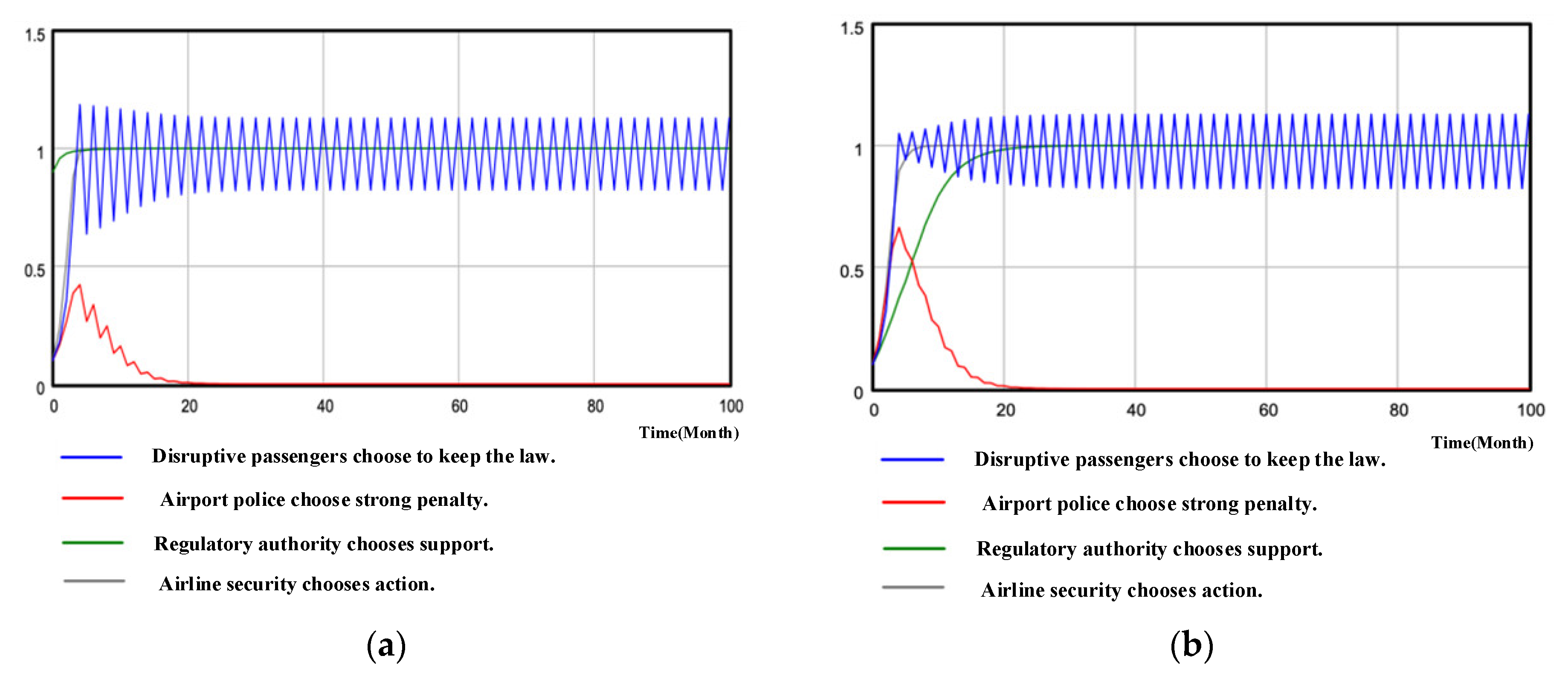
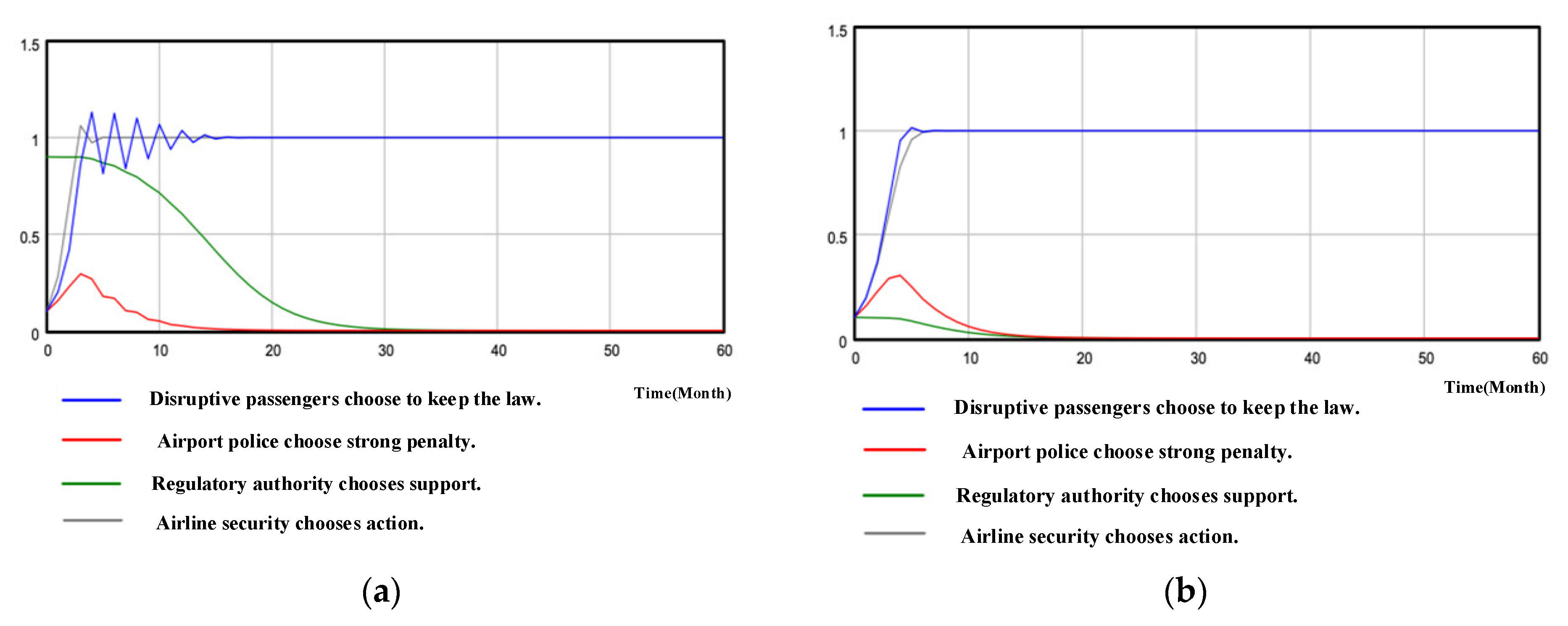
| Serial Number | Use of Open Flame or Smoking Path Event in the Cabin | Formula | Data | Failure Probability |
|---|---|---|---|---|
| 1 | Use of open flame or smoking in the cabin | Formula (1) | ||
| 2 | Airline security in-flight study of incidents | Formula (2) | ||
| 3 | Airline security in-flight dispose incidents | Formula (3) | ||
| 4 | Use of open flame or smoking passengers to stop the behavior | Formula (4) | ||
| 5 | Transferred under the plane to the airport police | Formula (5) | ||
| 6 | Airport police impose penalty | Formula (6) |
| Subjects | Variable | Explanations | Notes |
|---|---|---|---|
| Regulatory authority | The probability of regulatory authority choosing support. | ||
| The costs of regulatory authority support. | — | ||
| The benefits of regulatory authority support. | |||
| The benefits of regulatory authority nonsupport. | |||
| The enhancement of regulatory authority credibility when it chooses support. | — | ||
| The loss of regulatory authority credibility when it chooses nonsupport. | — | ||
| Airline security | The probability of airline security choosing action. | ||
| The benefits of airline security action. | |||
| The benefits of airline security inaction. | |||
| The acquisition of airline security duties and rights when it chooses action. | — | ||
| The increase in enforcement difficulties when regulatory authority chooses nonsupport and airline security chooses action. | — | ||
| The reduction in disposal costs when airport police choose strong penalty. | — | ||
| Airport police | The probability of airport police choosing strong penalty. | ||
| The costs of airport police choosing strong penalty. | |||
| The costs of airport police choosing weak penalty. | — | ||
| The enhancement of deterrence capability when disruptive passengers choose to break the law and airport police choose strong penalty. | — | ||
| The loss of deterrence capability when disruptive passengers choose to break the law and airport police choose weak penalty. | — | ||
| Disruptive passengers | The probability of disruptive passengers choosing to keep the law. | ||
| The costs of disruptive passengers choosing to break the law. | — | ||
| The additional benefits of disruptive passengers choosing to break the law. | — | ||
| The penalty of disruptive passengers choosing to break the law when airline security chooses action. | — | ||
| The penalty of disruptive passengers choosing to break the law when airport police choose strong penalty. | |||
| The penalty of disruptive passengers choosing to break the law when airport police choose weak penalty. | — | ||
| The probability of social loss when disruptive passengers choose to break the law. | |||
| The social loss of disruptive passengers choosing to break the law. | — |
| Strategy | Strong Penalty | Weak Penalty | |||
|---|---|---|---|---|---|
| Keep the Law | Break the Law | Keep the Law | Break the Law | ||
| Support | Action | ||||
| Inaction | |||||
| Nonsupport | Action | ||||
| Inaction | |||||
| Equilibrium Points | Eigenvalue λ1 | Eigenvalue λ2 | Eigenvalue λ3 | Eigenvalue λ4 |
|---|---|---|---|---|
| Equilibrium Point | ||||
|---|---|---|---|---|
| Variable | Explanation | Default |
|---|---|---|
| The costs of regulatory authority support. | 1 | |
| The benefits of regulatory authority support. | 2 | |
| The benefits of regulatory authority nonsupport. | 1 | |
| The enhancement of regulatory authority credibility when it chooses support. | 0.2 | |
| The loss of regulatory authority credibility when it chooses nonsupport. | 0.2 | |
| The benefits of airline security action. | 1 | |
| The benefits of airline security inaction. | 0.5 | |
| The acquisition of airline security duties and rights when it chooses action. | 0.1 | |
| The increase in enforcement difficulties when regulatory authority chooses nonsupport and airline security chooses action. | 0.1 | |
| The reduction in disposal costs when airport police choose strong penalty. | 0.2 | |
| The costs of airport police choosing strong penalty. | 1 | |
| The costs of airport police choosing weak penalty. | 0.5 | |
| The enhancement of deterrence capability when disruptive passengers choose to break the law and airport police choose strong penalty. | 0.1 | |
| The loss of deterrence capability when disruptive passengers choose to break the law and airport police choose weak penalty. | 0.1 | |
| The costs of disruptive passengers choosing to break the law. | 0.1 | |
| The additional benefits of disruptive passengers choosing to break the law. | 0.5 | |
| The penalty of disruptive passengers choosing to break the law when airline security chooses action. | 1 | |
| The penalty of disruptive passengers choosing to break the law when airport police choose strong penalty. | 2 | |
| The penalty of disruptive passengers choosing to break the law when airport police choose weak penalty. | 1 | |
| The probability of social loss when disruptive passengers choose to break the law. | 0.5 | |
| The social loss of disruptive passengers choosing to break the law. | 5 |
| Variable | Explanation | Default |
|---|---|---|
| The costs of regulatory authority support. | 1 | |
| The benefits of regulatory authority support. | 1.5 | |
| The benefits of regulatory authority nonsupport. | 0.6 | |
| The enhancement of regulatory authority credibility when it chooses support. | 0.1 | |
| The loss of regulatory authority credibility when it chooses nonsupport. | 0.1 | |
| The benefits of airline security action. | 2 | |
| The benefits of airline security inaction. | 1 | |
| The acquisition of airline security duties and rights when it chooses action. | 0.2 | |
| The increase in enforcement difficulties when regulatory authority chooses nonsupport and airline security chooses action. | 0.2 | |
| The reduction in disposal costs when airport police choose strong penalty. | 0.2 | |
| The costs of airport police choosing strong penalty. | 1 | |
| The costs of airport police choosing weak penalty. | 0.5 | |
| The enhancement of deterrence capability when disruptive passengers choose to break the law and airport police choose strong penalty. | 0.1 | |
| The loss of deterrence capability when disruptive passengers choose to break the law and airport police choose weak penalty. | 0.1 | |
| The costs of disruptive passengers choosing to break the law. | 0.01 | |
| The additional benefits of disruptive passengers choosing to break the law. | 0.1 | |
| The penalty of disruptive passengers choosing to break the law when airline security chooses action. | 1 | |
| The penalty of disruptive passengers choosing to break the law when airport police choose strong penalty. | 2 | |
| The penalty of disruptive passengers choosing to break the law when airport police choose weak penalty. | 1 | |
| The probability of social loss when disruptive passengers choose to break the law. | 0.7 | |
| The social loss of disruptive passengers choosing to break the law. | 1 |
Disclaimer/Publisher’s Note: The statements, opinions and data contained in all publications are solely those of the individual author(s) and contributor(s) and not of MDPI and/or the editor(s). MDPI and/or the editor(s) disclaim responsibility for any injury to people or property resulting from any ideas, methods, instructions or products referred to in the content. |
© 2023 by the authors. Licensee MDPI, Basel, Switzerland. This article is an open access article distributed under the terms and conditions of the Creative Commons Attribution (CC BY) license (https://creativecommons.org/licenses/by/4.0/).
Share and Cite
Wu, Y.; He, S.; Zhang, Q.; Shi, J.; Xie, J. Evolution Game and Simulation Analysis of Disturbance Emergency Disposal of In-Flight Cabin: China Civil Aviation Security Strategy Study. Sustainability 2023, 15, 9029. https://doi.org/10.3390/su15119029
Wu Y, He S, Zhang Q, Shi J, Xie J. Evolution Game and Simulation Analysis of Disturbance Emergency Disposal of In-Flight Cabin: China Civil Aviation Security Strategy Study. Sustainability. 2023; 15(11):9029. https://doi.org/10.3390/su15119029
Chicago/Turabian StyleWu, Yu, Shiting He, Qingsong Zhang, Jinxin Shi, and Jiang Xie. 2023. "Evolution Game and Simulation Analysis of Disturbance Emergency Disposal of In-Flight Cabin: China Civil Aviation Security Strategy Study" Sustainability 15, no. 11: 9029. https://doi.org/10.3390/su15119029




